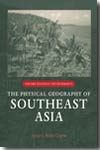The physical geography of Southeast Asia
- ISBN: 9780199248025
- Editorial: Oxford University Press
- Fecha de la edición: 2005
- Lugar de la edición: Oxford. Reino Unido
- Colección: Oxford Regional Environments
- Encuadernación: Cartoné
- Medidas: 25 cm
- Nº Pág.: 592
- Idiomas: Inglés

The Physical Geography of Southeast Asia examines the complex mosaic of physical environments which comprise Southeast Asia, and the current environmental problems and management practices which have arisen in this part of the world. The book is in three sections. The first section introduces the basic environmental components (geology, landforms, rivers, vegetation, and others) across the entire region. The second section discusses specific environments that are characteristic of this assemblage of continental and maritime landscapes (volcanic islands, coastal environment, granitic terrains, karst, etc.). The third and final section illustrates the ecological relationship between the environment and people (volcanic hazards, urban environment, coastal zone development, coral reefs, and others). The physical environment of Southeast Asia is examined at different levels, covering a world region that ranges from ancient, stable landmasses to dynamic, unstable plate boundaries, from aged, primary rainforests to brash, vibrant, resource-demanding built environments. Southeast Asia has been perceived as a laboratory for studying plate tectonics. It is an assemblage of large river basins, peninsulas and archipelagos, and seas surrounded by islands. It is an area of great physical variations where parts of the physical environment have been significantly degraded anthropogenically, following rapid population growth and development. In large parts of the region, the forms and processes on land and offshore should no longer be seen as entirely natural. As this book repeatedly illustrates, plate tectonics and people are both important contributors to the physical geography of Southeast Asia. The contributors to this volume are distinguished, scholarly, and have a long association with Southeast Asia. The chapters are not only skilfully built on state-of-the-art research findings but also include new material from the on-going research activities of the authors. The book goes
Ed. Avijit Gupta






